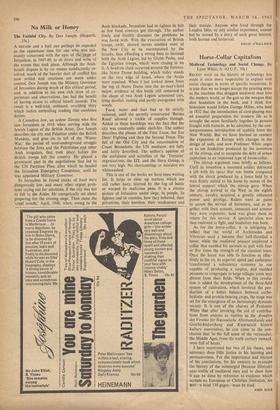No Milk or Honey
A DECADE and a half can perhaps be regarded n as the opportune time for one who was inti- mately concerned with the epic of the siege of Jerusalem, in 1947-49, to sit down and write of the events that took place. Although the Arab- Israeli dispute is by no means satisfactorily re- solved, much of the heavier dust of conflict has now settled and emotions are more under control. Dov Joseph was the Military Governor of Jerusalem during much of this critical period, and, in addition to his own rich store of ex- periences and observations, has had the benefit of having access to official Israeli records. The result is a well-told, unbiased, revealing story which makes enthralling reading that outshines fiction. A Canadian Jew, an ardent Zionist who first saw Jerusalem in 1918 when serving with the Jewish Legion of the British Army, Dov Joseph describes the city and Palestine under the British Mandate, and goes on to tell of the 'Winter War,' the period of semi-underground struggle between the Jews and the Palestinian and other Arab irregulars, that took place before the British troops left the country. He played a prominent part in the negotiations that led to the UN Partition Plan, after which he headed the Jerusalem Emergency Committee, until he was appointed Military Governor. In Jerusalem he found stocks of food were dangerously low, and many other urgent prob- lems crying out for attention, if the city was not to fall to the Arabs. He energetically set about preparing for the coming siege. Then came the 'cruel month,' April, 1948, when, owing to the Arab blockade, Jerusalem had to tighten its belt as few food convoys got through. The author freely and frankly discusses the problems he was faced with. With the evacuation of British troops, swift, shrewd moves enabled most of the New City to be encompassed by the Israelis, thus affording a strong base to forestall both the Arab Legion, led by Glubb Pasha, and the Egyptian troops, which were closing in on it. A head-on clash occurred around the fortress- like Notre Dame building, which today stands on the very edge of Israel, where the Arabs were repulsed. When I last looked down from the top of Notre Dame into the no-man's-land below, evidence of this battle still remained in the shape of two Arab Legion armoured cars, lying derelict, rusting and partly overgrown with weeds. Food, water and fuel had to be strictly rationed, until the secretly constructed 'Burma Road' allowed a trickle of supplies through. Added to these hardships was the fact that the city was constantly under shell-fire. The author describes the phases of the First Truce, the Ten Days' Fighting and then the Second Truce. The fall of the Old City and the assassination of Count Bernadotte, the UN mediator, are fully and fairly described. The author's opinion of the usefulness and activities of the 'Terrorist' organisations, the IZL and the Stern Group, is not very high. No shortcomings or mistakes are whitewashed. This is one of the books we have been waiting for. It helps to clear up matters which are still rather hazy, blurred by the fog of battle or warped by malicious pens. It is a sincere picture of Jerusalem under siege, its people, its fighters and its enemies, how they behaved, their privations, their heroism, their weaknesses and their morale. Anyone who lived through the London blitz, or any similar experience, cannot but be moved by a story of such great interest, both human and historical.
EDGAR O'BALLANCE


































 Previous page
Previous page